Dietary supplementation with crude extract from the red microalga P. cruentum significantly increased the immunocompetence and survival of Pacific white shrimp
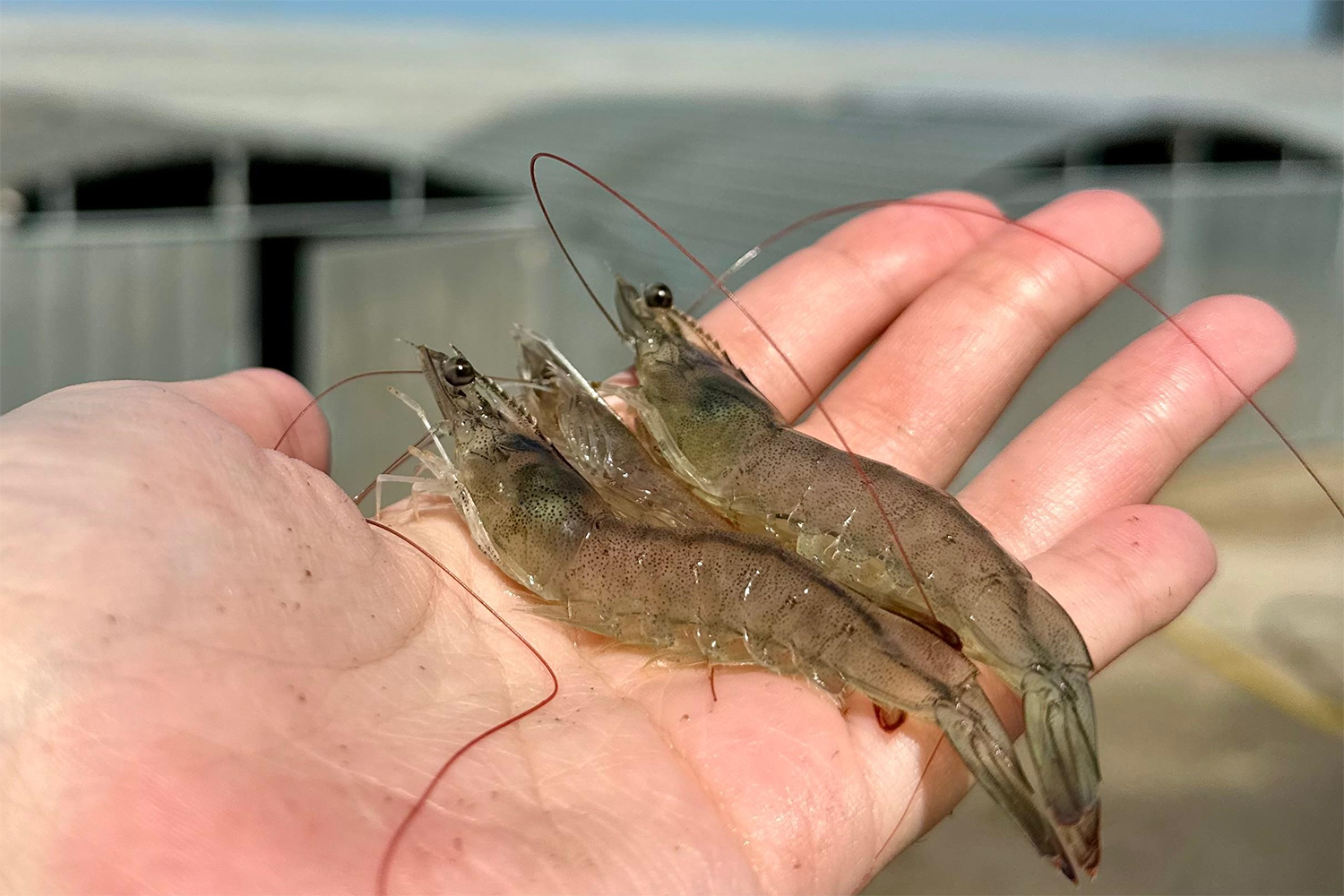
Biocompounds that improve marine shrimp immunocompetence are a sustainable solution against pathogens, and health-promoting additives may contribute to the success of P. vannamei farming. Substances with immunostimulant potential can activate nonspecific defense systems in farmed shrimp [such as total hemocyte count, THC (hemocytes are hemolymph – analogous to blood in arthropods – cells, and their total count reflects immune status of the animal) and phenoloxidase activity, PO (a major immune defense system in invertebrates] and improve animal survival rates.
Several researchers have demonstrated that the polysaccharides of marine algae can boost the resistance of Pacific white shrimp (Penaeus vannamei) against stress conditions and pathogens. In addition to its nutritional properties, microalgal biomass has received significant attention for its antioxidant, antibacterial, antifungal, and antiviral properties.
The red microalga Porphyridium cruentum is a potential source of many bioactive substances – like sulphated polysaccharides, phycobilins, polyunsaturated fatty acids, and others – but their use in aquaculture has not been well studied. During the stationary phase of their growth curve, these cultivated microalgae produce a massive quantity of exopolysaccharides (EPSs) composed of different sugars, including xylose, galactose, glucose, mannose, arabinose, and sulfated oligosaccharides, which offer a wide range of applications with biotechnological potential.
In aquaculture research, it has already been shown that EPSs from this microalga exhibit anti-VHSV (viral hemorrhagic septicemia virus, a key pathogen in fish farming) activity. Furthermore, immersion baths with EPSs improved immunological parameters in P. vannamei exposed to V. harveyi, making EPSs promising candidates for use as preventive agents against vibriosis.
This article – summarized from the original publication (Ozório, R.A. et al. 2024. Crude Polysaccharide Extract from the Microalga Porphyridium cruentum Improved Nonspecific Immune Responses and Resistance in Penaeus vannamei Exposed to Vibrio alginolyticus. Aquac. J. 2024, 4(3), 104-113) – presents the results of a study to assess the outcome of various inclusion levels of crude extracts from the microalga P. cruentum for possible immunomodulatory effects on L. vannamei shrimp.
Study setup
The P. cruentum strain was provided by the Laboratory of Algae Cultivation at the Federal University of Santa Catarina (UFSC), Brazil. Different crude extract concentrations (0.5, 1.0, 1.5, and 2.0 percent) were added to a commercial marine shrimp feed (Guabitech 1.6 mm Guabi®, Campinas, Brazil). The feed was ground into 5.0 kg lots, and each lot received a different dose according to the P. cruentum crude extract concentrations mentioned above.
Two thousand specific pathogen-free (SPF) P. vannamei juveniles with an initial weight of 6.6 ± 0.2 grams were randomly distributed into 20, 12 square meter fiberglass tanks, with four tanks for each treatment and 100 shrimp per tank). The five experimental diets were randomly assigned to four tanks, and for 30 days the shrimp were fed ad libitum twice daily. After this dietary supplementation, the shrimp were exposed to a V. alginolyticus challenge, and PO activity, THC, and shrimp survival were evaluated pre- and post-challenge to verify possible immunomodulatory effects on the shrimp.
For detailed information on the experimental design, animal husbandry, diet preparation and sample collection and analyses, refer to the original publication.
Results and discussion
At 30 days following the feeding assay during the pre-challenge period, no significant difference was observed in THC levels among treatments. However, an increase in the absolute number of THC was observed, mainly in the 1.0 percent treatment group compared to that of the control group. After the V. alginolyticus challenge, THC decreased in all treatments, but the control (0 percent) exhibited the most significant decrease at 39.42 percent (18.9 ± 1.3 × 10^6 cells/mL) in comparison to the pre-challenge THC level (31.2 ± 3.4 × 10^6 cells/mL) which was significantly different from that of the other supplemented treatments (Fig. 1). This suggests that the supplemented diet could have assisted in maintaining the quantity of circulating hemocytes in the infected shrimp. This result seems to be associated with an inflammatory response from the hemocytes that migrate to the inoculation region.
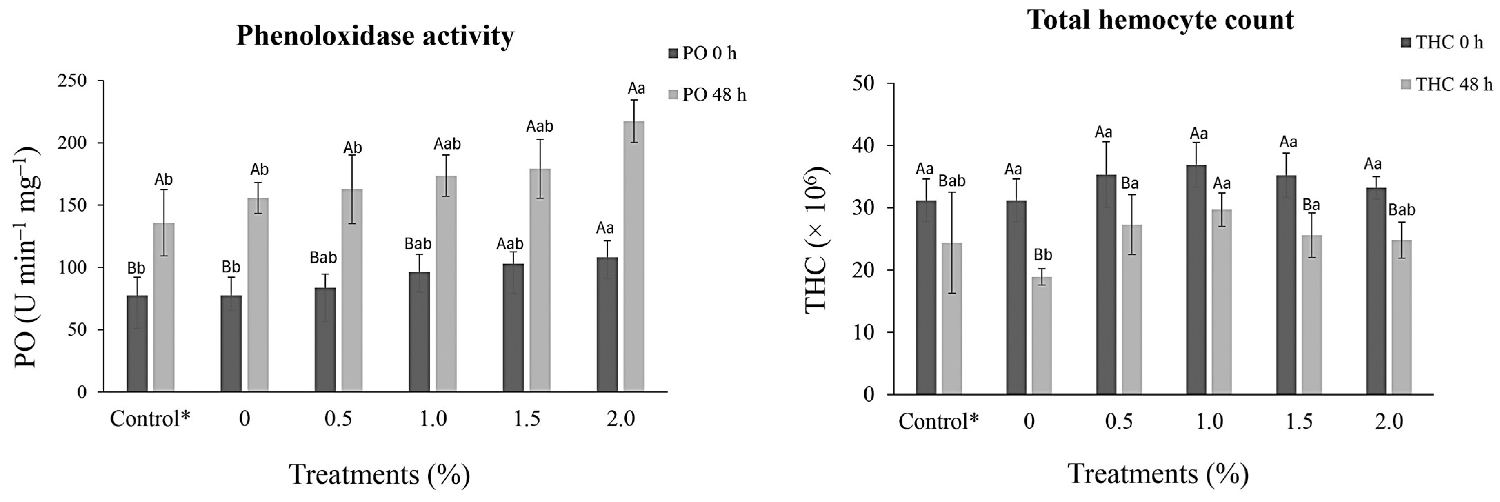
P. vannamei injected only with saline solution had a 100 percent survival rate 48 h after the challenge. In the other treatments, the survival rate differed significantly at both 24 hours and 48 hours. At 24 hours post-challenge, P. vannamei in the 1.0 percent treatment group showed a significantly greater survival rate than that of shrimp in the 2.0 percent treatment and control groups (0 percent).
The lowest survival rate at 48 hours post-challenge was recorded for the 0 percent control group (57.5 percent), and 48 hours after challenge, the survival rates remained unchanged in the 1.0 percent treatment group, further revealing a significant difference in survival rate (p < 0.05) compared to that of either the 2.0 percent treatment or control groups (0 percent). The lowest survival rates occurred in the 0 percent control group, which presented high mortality in both the 24-hour and 48-hour post-challenge periods (Fig. 2).
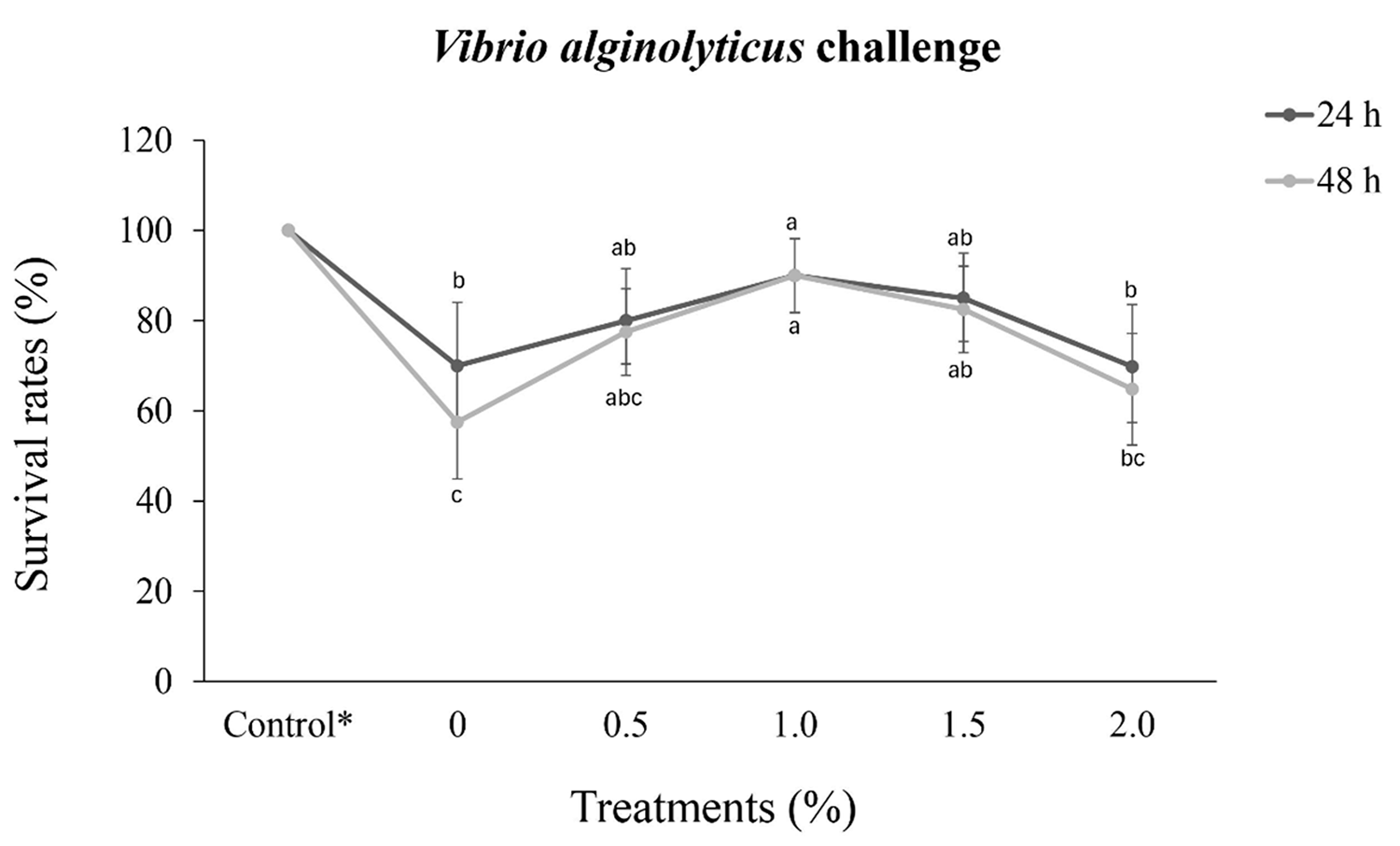
This is the first published report on the use of polysaccharides from the red microalga P. cruentum as a feed supplement for P. vannamei. Other researchers have reported similar results with the addition of fucoidan from the brown seaweed Sargassum polycystum to the diet of black tiger shrimp (Penaeus monodon), which significantly increased the survival rate of animals infected with white spot syndrome virus (WSSV).
The positive immunostimulant effect of P. cruentum crude extract have been reported by other researchers to have promise since microalgal cultures may be produced using shrimp farming effluents, possibly reducing production costs. Other microalgal genera, such as Arthrospira (Spirulina) and Chlorella, also exhibited satisfactory immunostimulation of shrimp, for example, by boosting phagocytic activity.
In the present study, the decrease in THC levels in shrimp fed a diet supplemented with P. cruentum crude extract was lower than that in the control group without supplementation. This result may be associated with faster hemocyte repositioning in the circulation by the hematopoietic tissue of shrimp fed the crude extract. Reports in the literature about the effects of sulfated polysaccharide immunostimulants are controversial and difficult to compare, mainly because of the various methodologies used for polysaccharides and their different compositions.
Assessing effective prophylaxis after the first contact with the pathogen is a major obstacle to consolidating the use of immunostimulants in aquaculture. However, we determined in this study that shrimp survival after the V. alginolyticus challenge was significantly greater in the 1.0 percent supplementation treatment group, suggesting a baseline from which it could be determined that dietary supplementation was sufficiently effective to increase immunocompetence in P. vannamei, thereby contributing effectively to the increased survival rate of the experimental animals.
Perspectives
Dietary supplementation with crude extract from the red microalga P. cruentum significantly increased the immunocompetence and survival of the Pacific white shrimp P. vannamei. Considering the results observed in the present study, a concentration of 1.0 percent is recommended for the dietary inclusion of P. vannamei. However, other immunological parameters, as well as immune protein expression, must be evaluated to confirm these results. In this context, we anticipate further studies to elucidate the mechanisms of action of these polysaccharide crude extracts and their prophylactic efficacy.
Now that you've reached the end of the article ...
… please consider supporting GSA’s mission to advance responsible seafood practices through education, advocacy and third-party assurances. The Advocate aims to document the evolution of responsible seafood practices and share the expansive knowledge of our vast network of contributors.
By becoming a Global Seafood Alliance member, you’re ensuring that all of the pre-competitive work we do through member benefits, resources and events can continue. Individual membership costs just $50 a year.
Not a GSA member? Join us.
Author
-
Marco Shizuo Owatari, Ph.D.
Corresponding author
Laboratory of Algae Cultivation, Aquaculture Department, Federal University of Santa Catarina, Florianópolis CEP 88034-000, Brazil
Tagged With
Related Posts

Health & Welfare
A study of Zoea-2 Syndrome in hatcheries in India, part 1
Indian shrimp hatcheries have experienced larval mortality in the zoea-2 stage, with molt deterioration and resulting in heavy mortality. Authors investigated the problem holistically.
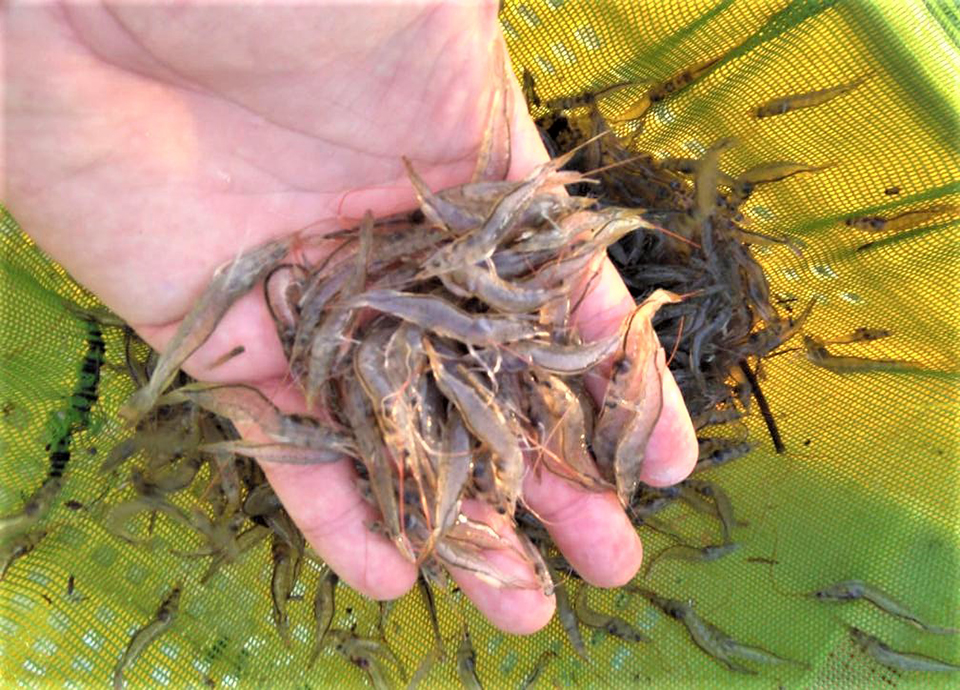
Health & Welfare
Comparing water disinfection by ozonation, UV irradiation in a brackish water RAS for Pacific white shrimp
In shrimp RAS, use of ozone stabilized water microbial composition, biofilms and shrimp carapaces, controlled nitrite and accelerated nitrate degradation.
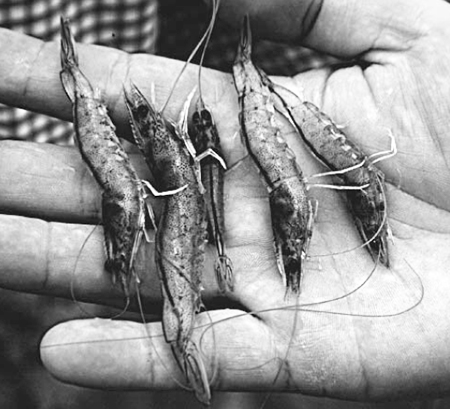
Health & Welfare
Environmental factors affect immune response and resistance in crustaceans
Environmental stresses affect the immune response of shrimp in a dose-dependent way, increasing susceptibility to disease.
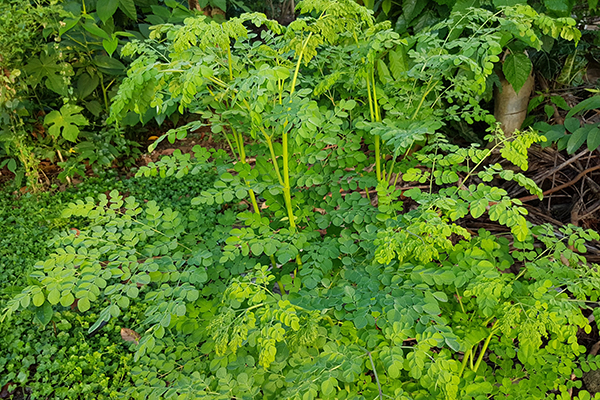
Health & Welfare
Moringa leaf extract can boost Pacific white shrimp immune responses
Including moringa leaf extract at a certain level enhanced immune response, growth and resistance of L. vannamei against V. alginolyticus infection.



